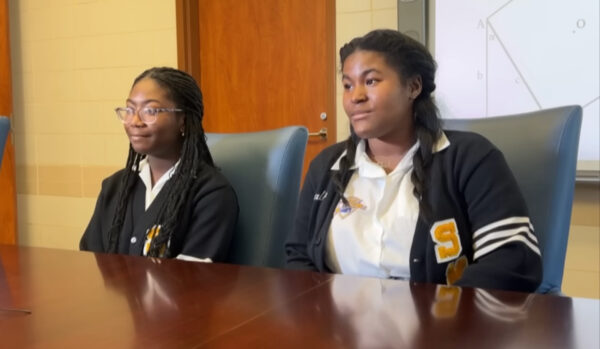Two Black teens from New Orleans may have made mathematical history by proving the Pythagorean theorem by using trigonometry.
In a presentation at one of the nation’s most esteemed math societies, the girls claimed they’ve done something that no academic in the past 2,000 years has done.
Calcea Johnson and Ne’Kiya Jackson presented their findings at the American Mathematical Society’s Annual Southeastern Conference on Saturday, March 18. While both young ladies authored the research, only Jackson presented in this special session for undergraduates in the study of mathematics and statistics.
The young ladies were motivated by their teachers who stressed the school’s motto.

“Our slogan is ‘No Excellence Without Hard Labor.’ So, they definitely push us,” Johnson said about their support from the educators in her school, reports 4WWL.
While other presenters hailed from institutions like Georgia State University, Georgia Institute of Technology, Clemson University, Florida State University, Carleton College, and California State University, the two seniors at St. Mary’s Academy in New Orleans were the only presenters who were still in high school.
“You don’t see kids like us doing this. It’s usually like you have to be an adult to do this,” Johnson remarked.
The two were proud of their presentation — especially standing side by side with other older scholars who are now their peers.
“It’s really an unparalleled feeling, honestly, because there’s just nothing like being able to do something that people don’t think young people can do,” Johnson said.
Adding, “A lot of times you see this stuff, you don’t see kids like us doing it.
St. Mary’s Academy is a predominantly Black Catholic institution, with 99.8 percent of its more than 400 students identifying as Black. Sources say the teachers are engaging and “genuinely care about the students” while pushing them toward excellence.
Jackson agrees, saying, “We have really great teachers.”
The Pythagorean theorem has been proven before in other mathematical disciplines such as algebra and geometry, but not through trigonometry, the girls said.
In an abstract from their presentation, Johnson and Jackson state, “In the 2,000 years since trigonometry was discovered it’s always been assumed that any alleged proof of Pythagoras’s Theorem based on trigonometry must be circular.”
Johnson and Jackson cited noted math educator Elisha Loomis’ accepted beliefs about the theorem after being challenged by their high school teachers.
Loomis stated in his book, “The Pythagorean Proposition” in 1940, “There are no trigonometric proofs because all the fundamental formulae of trigonometry are themselves based upon the truth of the Pythagorean Theorem.”
The teens set out to show that may not be true.
In their lecture, the two geniuses offered “a new proof of Pythagoras’s Theorem which is based on a fundamental result in trigonometry—the Law of Sines—,” saying, “we show that the proof is independent of the Pythagorean trig identity \sin^2x + \cos^2x = 1.”
Many took to social media to celebrate Johnson and Jackson.
Despite their age, Catherine Roberts, the executive director of the American Mathematical Society wants the girls to submit their work to be examined by a peer-reviewed journal, where it can be contrasted against the works of scholars like Jason Zimba and Nuno Luzia. Both Zimba and Luzia have presented their work on proving Pythagoras’ Theorem also.
“Members of our community can examine their results to determine whether their proof is a correct contribution to the mathematics literature,” Roberts stated, according to The Guardian.
The executive director also encouraged AMS members to “celebrate these early career mathematicians for sharing their work with the wider mathematics community,” saying, “We encourage them to continue their studies in mathematics.”


